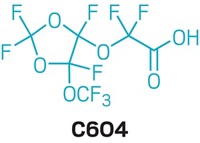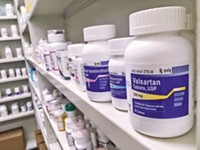Advertisement
Grab your lab coat. Let's get started
Welcome!
Welcome!
Create an account below to get 6 C&EN articles per month, receive newsletters and more - all free.
It seems this is your first time logging in online. Please enter the following information to continue.
As an ACS member you automatically get access to this site. All we need is few more details to create your reading experience.
Not you? Sign in with a different account.
Not you? Sign in with a different account.
ERROR 1
ERROR 1
ERROR 2
ERROR 2
ERROR 2
ERROR 2
ERROR 2
Password and Confirm password must match.
If you have an ACS member number, please enter it here so we can link this account to your membership. (optional)
ERROR 2
ACS values your privacy. By submitting your information, you are gaining access to C&EN and subscribing to our weekly newsletter. We use the information you provide to make your reading experience better, and we will never sell your data to third party members.
Pharmaceutical Chemicals
Bosutinib Buyer Beware
Molecule Mix-up: The wrong isomer has been sold under the name of the cancer-fighting compound
by Bethany Halford
May 11, 2012
CLARIFICATION: This story was modified on May 15, 2012, to clarify the relationship between LC Laboratories and Steven G. Boxer. The sentence that previously read, “Boxer, however, says he has not yet received a requested refund,” has been updated to read, “Boxer says he has not yet received a requested refund, which Driedger insists LC Laboratories does not owe him under the terms of its warranty to customers.”
Some bad bosutinib is going around. Scientists who have purchased the compound may have actually received an isomer rather than the genuine molecule.
Bosutinib, also known as SKI-606, is currently in Phase III clinical trials to treat chronic myeloid leukemia. Officials at Pfizer, the company sponsoring the clinical trials, say that only genuine bosutinib has been administered to patients. However, as a selective kinase inhibitor, the compound is also used in medical and basic research. The news that researchers may have unwittingly been using an isomer of bosutinib instead of using the genuine compound threatens to invalidate research efforts around the world.
The first inklings that there may be problems in the bosutinib supply were discovered in December, when Nicholas M. Levinson, a postdoc at Stanford University, noticed something funny in the Protein Data Bank. A structure recently deposited by Stefan Knapp, Frank von Delft, and coworkers at England’s Oxford University was supposed to show bosutinib bound to a kinase, but the arrangement of one of the ligand’s atoms was wrong.
It was a subtle difference. Bosutinib has a chloro group on the 2-position of its aniline subunit, but this was missing in the Oxford structure. Instead, this molecule appeared to have a chlorine in the 3-position, where bosutinib has only a hydrogen.
Levinson had been working on the structure of bosutinib bound to a different kinase, and when he saw this new structure, it convinced him that what had been a nagging inconsistency in his own work was actually a widespread problem.
In Levinson’s structure, which was of lower resolution than Knapp and von Delft’s, the electron density for one of bosutinib’s atoms—the chlorine in the 2-position—was weak, Levinson says. “It looked like that atom was missing, but it is possible to have weak density for regions of a structure if those groups are poorly ordered. If they’re a little bit flexible the electron density gets smeared out over space. That can happen even if the atom is there. So I didn’t immediately think that we had the wrong thing, but it made me nervous,” he recalls.
When he saw the same atom missing in the Oxford group’s higher resolution structure “that immediately told me that this was a problem affecting multiple people,” Levinson says.
Steven G. Boxer Levinson’s postdoctoral adviser, vividly remembers getting the call from Levinson that there may be a problem with their bosutinib research. He was standing in the rain at New York’s John F. Kennedy airport on his way to give a seminar at Columbia University. He and Levinson had prepared a publication on the interaction of this so-called bosutinib with a domain of Abl tyrosine kinase. The paper had been peer reviewed, accepted, and was in galley proofs. It was, Boxer recalls, just a mouse click away from appearing in PLoS One.
Levinson and Boxer put their publication on hold, ordered bosutinib from a different vendor, and did a battery of tests to determine which material was the genuine bosutinib. They soon figured out the original compound they had done all their research on turned out not to be bosutinib. “We had wasted a huge amount of time and money on the wrong isomer,” Boxer says.
On the basis of multidimensional nuclear magnetic resonance (NMR) experiments, Boxer and Levinson believe that this isomer not only has a chlorine at the 3-position rather than the 2-position, but also that the chloro and methoxy groups that appear in the 4- and 5-positions, respectively, in bosutinib’s aniline moiety have been switched.
The difference between the two molecules is subtle. Mass spectrometry and elemental analysis would be the same for both compounds. There are differences in the aromatic region of the 1H NMR, but one wouldn’t necessarily pick up on them unless they compared the two compounds side by side. It’s only when you use 13C NMR that the symmetrical nature of the aniline group in the isomer becomes clear.
Most companies will provide a high-performance liquid chromatography (HPLC) analysis to show that the material they supply is pure, but that, Boxer notes, doesn’t really reveal much. “What we got was pure—just the wrong compound,” he says.
“We all, reasonably, believe that what we purchase from chemical and biological suppliers is what they say it is and that they have documentation to support this,” Boxer points out. “But these suppliers are often just distributors, and the actual origin of the compound is largely a matter of faith for the end user,” he says.
“This is something almost any lab could fall prey to and not know it,” Boxer continues. “We’re pretty sophisticated. We’re in a chemistry department. We have these analytical methods available to us. We’re comfortable doing this kind of detective work.”
That’s unlikely to be the case for most of the biology and medical researchers who use bosutinib. Many researchers might never know they used the wrong material, Levinson adds. “This isomer inhibits the target of bosutinib, Abl kinase, pretty efficiently. It’s a little bit worse but not sufficiently worse of an inhibitor that the cell biologists would notice,” he says.
One sign that the bosutinib problem might be fairly widespread is that the Oxford group and the Stanford researchers purchased their bosutinib from different vendors. Knapp bought the isomeric material from Calbiochem back in 2006. Boxer and Levinson purchased isomeric material in 2011 from LC Laboratories, which is a division of Woburn, Mass.-based PKC Pharmaceuticals.
Calbiochem no longer sells bosutinib, and its parent company, EMD Millipore, did not respond to C&EN’s request for comment.
Paul E. Driedger, chief executive officer of LC Laboratories and PKC Pharmaceuticals, says the incorrect material his company sold came from two different suppliers in China that he declined to name. “We don’t know the ultimate source of the material,” Driedger adds. “There are many traders in Asia and they’re all trading back and forth and getting material from wherever.”
Since learning from Boxer that his firm was selling the wrong material, Driedger has embarked on an extensive analytical effort to characterize the bosutinib that’s currently available in the marketplace. PKC’s X-ray crystal analysis of the material LC Laboratories sold as bosutinib confirms the structure that Boxer and Levinson propose. Driedger hopes to publish his efforts soon.
In January he posted a notice on the PKC website stating that at least two different compounds were being sold under the name bosutinib. On Feb. 20, he sent a letter alerting all 124 customers who had purchased bosutinib from LC Laboratories to the matter. At that time, he noted that his company had purchased bosutinib from 10 different vendors and found that eight were supplying the incorrect isomer. Since then, Driedger tells C&EN, the latter number had grown to 14. He plans to publicly identify all vendors who sold incorrect bosutinib on his website but had not done so as of C&EN’s press time.
C&EN contacted 16 different firms selling bosutinib. Of those, five said they made the material in-house, and 11 said that they purchased the material from an outside source. Only one, Sigma-Aldrich, would identify its supplier—Pfizer, which makes the bosutinib it supplies to Sigma-Aldrich.
Quality-control analyses of material purchased from outside sources varied. Some firms said they simply did HPLC to verify purity, while others reported using mass spectrometry, elemental analysis, and 1H NMR. None went so far as to do 13C NMR analysis.
It’s difficult to say how far the bosutinib problem extends into the research community, which is only just becoming aware of the problem. A PubMed search for bosutinib produces more than 100 results; a SciFinder search yields more than 300 references.
The date the Oxford researchers purchased their bad bosutinib indicates the incorrect material has been in commerce since at least 2006.
Ulrich Schweizer, a researcher at Germany’s Charité University of Medicine Berlin, tells C&EN it’s likely his lab used the isomeric material in research recently published in the Journal of Clinical Endocrinology & Metabolism (DOI: 10.1210/jc.2011-1837). “I still wonder what we could have done better,” Schweizer says. “Clearly, not every lab can run and analyze an NMR spectrum of every chemical compound ordered.”
An expert in organic synthesis examined the published syntheses of bosutinib and tells C&EN that the only reasonable explanation for the production of the isomeric material is that the wrong aniline starting material was used in the synthesis.
To see whether 3,5-dichloro-4-methoxy aniline has entered the supply chain mislabeled as 2,4-dichloro-5-methoxy aniline, Driedger has gathered and is testing supplies of the latter from 28 vendors worldwide.
Results from one academic group seem to confirm this hypothesis. A team led by Fei Li of China’s Nanjing Medical University reported an alternative synthesis of bosutinib in 2010 (Molecules, DOI: 10.3390/molecules15064261). However, the NMR data they report matches that of the isomer rather than genuine bosutinib. Li tells C&EN that they did not characterize their aniline starting material and they now believe they probably used the wrong isomer.
Richard D. Connell, head of external research solutions for Pfizer, tells C&EN they have not seen any incorrectly labeled aniline in the course of the company’s syntheses of bosutinib. Furthermore, Connell says, no isomeric material has been used in clinical trials. “Everything we make for the clinical trials was all made inside of Pfizer. We do a huge amount of analysis,” he says. “There never was and is not an issue with the clinical supplies going to patients.” He does note, however, that there is an “unregulated ecosystem” of chemical suppliers selling bootleg versions of drugs and clinical candidates. “Anybody who has a chemistry shop or can outsource samples can make whatever samples they want to,” Connell says.
He points out that there’s strong demand in the research community for such molecules. Pfizer, as well as other pharmaceutical companies, do make supplies of such compounds available free of charge to researchers, although investigators have to fill out some paperwork, which Pfizer then evaluates for scientific merit.
Connell acknowledges that some researchers find the paperwork onerous, so starting in 2010, Pfizer inked a deal with reagent vendors Sigma-Aldrich and Tocris Bioscience to sell research-grade versions of Pfizer compounds, made by Pfizer, to scientists. Last summer they extended the deal to include clinical candidates, such as bosutinib. Pfizer recently added Toronto Research Chemicals to its licensed suppliers.
“We started worrying about our brand. If someone took an impure sample or a bogus sample and then generated data, like Professor Boxer did, they waste a lot of research dollars and it’s very unproductive,” Connell says.
Connell says that instances of the wrong isomer being sold are “probably happening more than people realize.” He says that one of his licensed suppliers forwarded him an e-mail from a professor thanking them for making another Pfizer product, Xalkori (crizotinib), available. Apparently the researcher had been supplied with the incorrect isomer from an unlicensed vendor.
The chemical suppliers who spoke with C&EN said that, by and large, they don’t worry about materials they’ve purchased from outside sources. Problems such as those seen with bosutinib, they say, are rare.
For PKC’s Driedger, however, the problem is a constant worry.
“It’s a hazard for every compound in commerce,” he says.
Driedger says LC Laboratories will stand by its warranty for all its bosutinib customers. Boxer says he has not yet received a requested refund, which Driedger insists LC Laboratories does not owe him under the terms of its warranty to customers. Boxer and Levinson did eventually publish their results explaining how both bosutinib and the isomer interact with Abl, as well as the story of their detective work (PLoS One, DOI: 10.1371/journal.pone.0029828).
The whole bosutinib saga illustrates that researchers should never take for granted the identity of the chemicals they receive, Boxer says, but it also points to vulnerability in the system. “While we have good mechanisms for warning the chemical community about highly explosive or toxic materials, this is a more insidious problem,” he points out. “As far as I can tell, there is no mechanism, beyond publication, which will only be read by people interested in this area, to alert the scientific community.”






Join the conversation
Contact the reporter
Submit a Letter to the Editor for publication
Engage with us on Twitter